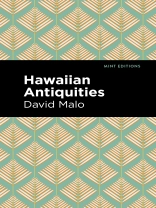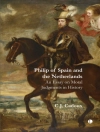Hawaiian Antiquities (1898) is an ethnography by David Malo. Originally published in 1838, Hawaiian Antiquities, or Moolelo Hawaii, was updated through the end of Malo’s life and later translated into English by Nathaniel Bright Emerson, a leading scholar of Hawaiian mythology. As the culmination of Malo’s research on Hawaiian history, overseen by missionary Sheldon Dibble, Hawaiian Antiquities was the first in-depth written history of the islands and its people. “The ancients left no records of the lands of their birth, of what people drove them out, who were their guides and leaders, of the canoes that transported them, what lands they visited in their wanderings, and what gods they worshipped. Certain oral traditions do, however, give us the names of the idols of our ancestors.” As inheritor of this ancient oral tradition, David Malo, a recent Christian convert who studied reading and writing with missionaries, provides an essential introduction to the genealogies, history, traditions, and stories of his people. Engaging with the legends passed down from ancient generations as well as the flora and fauna of the islands in his own day, Malo links the Hawaii of the past to the world in which he lived, a time of political and religious change introduced by missionaries from the newly formed United States. This edition of David Malo’s Hawaiian Antiquities is a classic work of Hawaiian literature reimagined for modern readers.
Since our inception in 2020, Mint Editions has kept sustainability and innovation at the forefront of our mission. Each and every Mint Edition title gets a fresh, professionally typeset manuscript and a dazzling new cover, all while maintaining the integrity of the original book.
With thousands of titles in our collection, we aim to spotlight diverse public domain works to help them find modern audiences. Mint Editions celebrates a breadth of literary works, curated from both canonical and overlooked classics from writers around the globe.
Om författaren
David Malo (1795-1853) was a Hawaiian scholar, educator, politician, and minister. Born in Keauhou, Malo was raised during the period of unification under Kamehameha I. As a young man, he served as oral historian and court genealogist of chief Kuakini and married A’alailoa, an older widow. In 1823, Malo became a student of Reverend William Richards on the island of Maui, learning to write in Hawaiian and English, as well as converting to Christianity. Following the deaths of his first and second wives, Malo married Lepeka, who took the name Rebecca and gave birth to a daughter, Emma, in 1846. In his official role, he composed laments—most notably, a grief chant on the death of Queen Ka’ahumanu—genealogies, and letters in the Hawaiian language. In addition, Malo worked to translate the Gospel of Matthew and formed the first Hawaiian Historical Society alongside Samuel Kamakau in 1841. That same year, he was elected to serve as a representative from Maui in the Legislature of the Hawaiian Kingdom.












